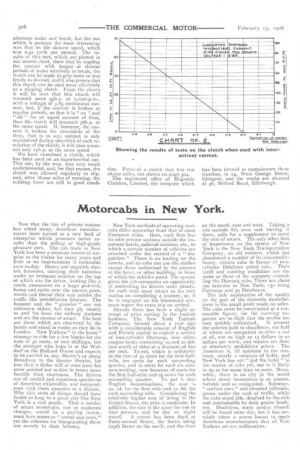Motorcabs in New York,
Page 6

If you've noticed an error in this article please click here to report it so we can fix it.
. Now that the tide of private custom has ebbed away, American manufacturers have turned to a new field of enterprise which promises better results than the selling of high-grade pleasure cars, The cab trade in New York has been a constant source of surprise to the visitor for many years and little or no improvement is noticeable even to-day. Heavy and ungainly electric hansoms, carrying their batteries under an immense erection on the top of which sits the driver, looking like a comic monument on a huge pedestal, bump and rattle over the uneven pavements and thread their way amidst the traffic like antedeluvian hearses. The hansom and the " growler " are not unknown either, but they ply mostly to and fro from the railway stations and are the reverse of smart, The best are those which are chartered by the hotels and stand in ranks as they do in London. New Yorkers " in the know" manage to ride for a few blocks for the sum of so cents, or two shillings, but the stranger who hops in at the Waldorf or the Holland House and expects to be carried to, say, Sherry's or along Broadway to the theatre district, for less than a dollar will at once have his error pointed out to him in terms more forcible than courteous. The drivers are all uncivil and rapacious specimens of American citizenship, and independence with them amounts to a disease. Why this state of. things should have lasted so long in a great city like New York is a real puzzle. That a service of smart motorcabs, run at moderate charges, would be a paying investment here seems to " sauter aux yeux," yet the schemes for inaugurating them are merely in their infancy. New York methods of operating taxicabs differ somewhat from that of most European cities. Here, each firm has its own private stations outside the important hotels, railroad stations, etc., to which a certain number of vehicles are attached under the control of a" dispatcher." There is no touting on the streets, and no cabs can use the station except those authorised by the owners of thehotel, or other building, in front of which the vehicles stand. The system gives the cab companies an -opportunity of controlling its drivers more closely, for each man must return to his own station on completing a journey, or, if he is engaged on his homeward run, must report the extra trip on arrival.
Already there has been a slight attempt at price cutting in the taxicab business. The New York Taxicab Company, formed about a year ago with a considerable amount of English and French capital to exploit a service of four-cylinder Darracqs, now offers coupon books containing ro and 20 dollars worth of rides at a discount of five per cent. Travel, which is ordinarily at the rate of 3o cents for the first halfmile, ten cents for each succeeding quarter, and to cents for each six minutes waiting, now becomes 28 cents for the first half-mile and 91 cents for each succeeding quarter. To put it into English denominations, the cost is 25. id. for the first mile and is. 8d. for each succeeding mile. Considering the relatively higher cost of living in the -United States, the price is moderate. In addition, the rate is the same for one or four persons, and for day or night
travel. A centre has been fixed at Forty-second Street, the limits being 125th Street on the north, and the river
on the south, east and west. Taking a cab outside this area and leaving it there, calls for a supplement to cover the cost of return. The only other firm of importance on the streets of New York is the New York Transportation Company, an old concern, which has abandoned a number of its abnormallyheavy, electric cabs in favour of twocylinder Delahaye petrol cabs. Their tariff and running conditions are the same as those of the company controlling the Darracq cabs. There are about 200 taxicabs in New York, rso being Darraeqs and so Delahayes.
The only explanation of the apathy on the part of the domestic manufacturer is the small profit made on sales. The cabs must be constructed at a reasonable figure, for the running expenses arc so high that the profits are
very quickly minimised. present the salaries paid to chauffeurs, not half of whom are competent to drive a car at all, run as high as 15 dollars to 2o dollars per week, and re-pairs are done at absolutely prohibitive prices. The American is, all opinions to the contrary, utterly a creature of habit, and New York has not " got the habit " in the matter of cabs yet, nor is it likely to do so for some time to come. Meanwhile, there is no city in the world where street locomotion is so uncomfortable and so antiquated. Subways, " surface cars," and elevated railroads, groan under the rush of traffic, while the cabs stand idle, despised by the rich and unattainable by their poorer brethren. Doubtless, some modus vivendi will be found some day, but it has certainly taken a severe lesson to teach American manufacturers that all New Yorkers are not millionaires.




















